An orchid is a beautiful plant, but at the same time capricious and expensive. That is why the happy owners of phalaenopsis and other species are so shaking over their brainchild. They create all the necessary conditions for keeping, constantly monitor the state of the plant, periodically plant overgrown bushes, and all this only so that their orchid feels good and does not need anything.
But there are such troubles that you cannot protect yourself with the correct temperature or watering regime. It’s about the attack of pests and the development of infections in orchids and white sticky on orchids leaves, stems, roots.
what is the white sticky stuff on orchids?
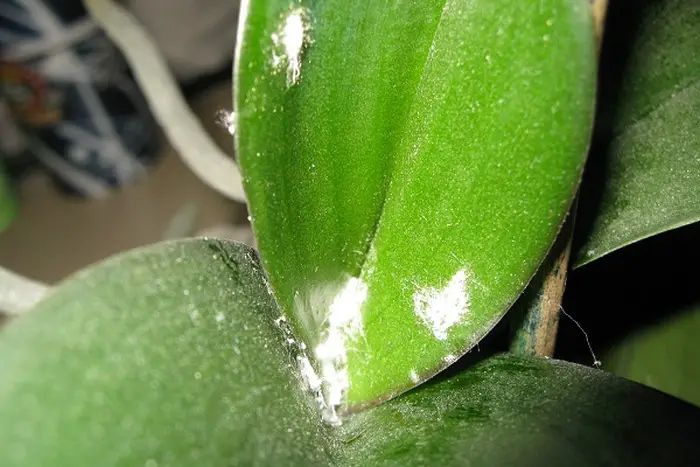
A white sticky coating can affect a flower in two cases: the plant has caught an infection or it has been attacked by pests. Both the first and the second are extremely dangerous for the orchid: it can quickly kill it. Treating such ailments is also quite difficult.
Note! If the orchid has been attacked by parasites, then you should notice a White Sticky formed on the leaves (less often on the stems), similar to cotton wool or flakes. This means that the plant has been sick for a long time since the first signs of pest damage are the formation of sticky drops on the surface of the leaves.
If the plant catches an infection, then the symptoms are somewhat different. Usually, with fungal infections, the lower surfaces of the leaf plates are primarily affected. They are covered with a powdery coating, which grows as the fungal spores develop. The danger is that the fungus grows very quickly, which means that the lack of timely treatment will lead to the decay of the orchid.
White Sticky can appear on the following areas of the plant:
- on leaves;
- stems;
- root system.
Here is guide on All Spots on orchid leaves: Symptoms, Causes, and treatment.
White Sticky On Orchids On the leaves
Often, diseases and infections affect orchid leaves. Overtime (and in the absence of proper treatment), the problem can spread to the stems, but rarely do the problems begin with them.
Usually at risk are those flowers that do not receive proper care. Their immune system weakens and opens the way for all possible infections, among which white plaque is the most common. Lack of proper care leads to a malfunction of metabolic processes in the orchid, and this, in turn, affects the composition of the plant sap. It is because of this that various diseases and pests perceive orchids as easy prey.
Depending on the cause of the lesion, the disease may look different. Most often, the main signs of a problem are:
- drying of orchid leaves and stems;
- premature end of flowering (poor flowering);
- inflorescences fade quickly, fall without even opening;
- sticky drops appear on the leaves;
- over time, the sticky drops turn into a white coating.
Important! If the plant has been infested with pests, then plaque appears on the front side of the leaf plates in the form of flakes or cotton fibers. If the plant is infected with a fungal infection, the disease will manifest itself on the back of the leaves and will look like powdery dust, rapidly growing over the surface of the leaf and stem.
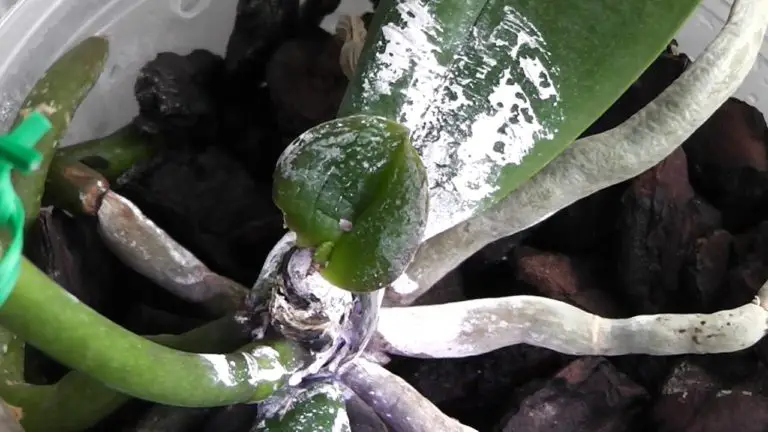
White Sticky On Orchids On stems
White Sticky rarely occurs on orchid stems. Most often, it goes there at the later stages of the development of the disease from the leaf plates. It usually looks like this:
- sticky drops of sweet secretion;
- white powdery dusting with the texture of cotton fibers;
- gray-green mold.
If you are facing problem Orchid Leaves Cracking read it out.
White Sticky On Orchids On the roots
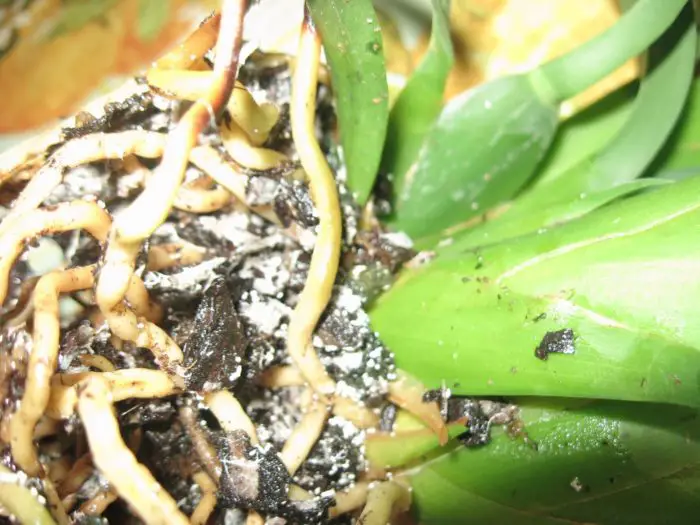
In most cases, the roots of an orchid undergo an infectious attack. This part of the plant is difficult for pests to access, so they prefer something simpler, such as leaves.
The main problem that orchid owners may face is mold. This fungal infection looks like a fibrous plaque that can appear on all parts of the plant (except for the inflorescences). Mold multiplies with the help of spores, so the disease spreads quickly, affecting all healthy areas in a short time. If a fungus has been brought into the house, expect a complete infection of the plants.
The color of the mold may vary:
- light gray (just this variety is called white);
- green;
- black.
Outwardly, it looks like a shaggy crust that covers the roots of the plant. This disease is also dangerous because it can stay dormant for a long time somewhere in the roots of an orchid. As soon as the external environment allows, the fungus immediately wakes up and begins its vigorous activity.
Important! Mold can infect all parts of the plant as it spreads through the voids between the bark of roots and stems and along the surface of the soil.
Cause of white sticky On orchids
There are many reasons for the appearance of a harmful white coating on an orchid. Most often, the plant gets sick:
- with improper care;
- non-compliance with the temperature regime;
- improper watering.
It is also worth noting that the development of the disease may be a consequence of substrate contamination. So thorough disinfection of all tools and soil is a prerequisite for normal plant growth.
Improper care
Many factors can be attributed to them. Most often, the plant suffers in the winter, since at this time the amount of natural light decreases, the air becomes drier, and water stagnates in the ground.
Decay of the root system and the formation of fungal deposits on roots, leaves or stems are common consequences of improper care. All this happens due to waterlogging of the soil.
As a result, the orchid:
- dies;
- attracts pests;
- rots, infecting the substrate.
Important! When watering, be guided by the consistency of the soil in the pot, not the time between waterings. If the soil is dry enough, you can add more water.
Careful adherence to the watering regime should also be associated with strict adherence to the temperature regime, since mealybugs that are dangerous for orchids feel quite comfortable in a dry and warm place, but they are afraid of moisture. To keep the roots healthy, while protecting the leaves and stems from pests, wipe the leaf blades with a damp cloth, and spray instead of watering.
The temperature regime in the summer should be kept within + 18 … + 30 degrees, in winter, + 20 … + 23 degrees is enough. Air humidity must be at least 55%.
The timely removal of dried parts of the plant is also important. This helps protect the orchid from the spread of pests. Standard pruning is an excellent preventative measure.
Infection in Growing Medium
Sometimes contaminated soil can be the cause of orchid disease. That is why most flower growers are advised to purchase ready-made soil mixes only in trusted stores.
If you prefer to prepare the substrate yourself, be sure to disinfect:
- Take a prepared bark for the substrate.
- Dry the bark in the oven at +60 degrees for 15–20 minutes to kill all possible pests and bacteria.
- Disinfect the plant seedlings before planting them in sterile soil.
After transplanting the plant, discard the growing medium from under it, especially if the plant is sick with something. In no case do not transplant other flowers into such soil, as there is a high risk of infection and death.
If your orchid roots dry shriveled you must take immediate steps toward the solution.
Powdery mildew

This disease most often affects the leaf plates of orchids. The primary signs of the presence of the disease appear only in small areas. That is why most flower owners do not notice them. Over time, the affected area increases significantly.
The carrier of powdery mildew is powdery mycelium, which is capable of multiplying to incredible sizes in a short time under favorable environmental conditions. Outwardly, it looks like a floured leaf surface.
Reasons for powdery mildew infection:
- sharp jumps in temperature;
- waterlogging of the soil;
- lack of timely therapeutic or preventive measures.
Lack of treatment for such an infection leads to the death of the plant.
mealybugs on orchids
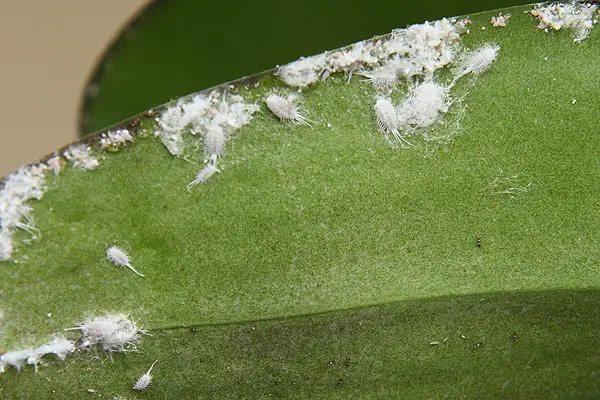
Mealybugs, otherwise called hairy lice or felt lice, belong to the family of hemiptera insects, which have nothing in common with the usual worms. Many inexperienced growers confuse scale insects with scale insects, although these insects are not even similar in appearance.
The mealybug has an oblong body 2–6 mm in length, beige or white. Their body is completely covered with a wax coating, reminiscent of ordinary flour. They have bristles on the sides, and two pairs of long hairs on the back.
In nature, there are many varieties of these pests. Only three species are dangerous to orchids:
- Bristly. Their females have a red tint of the body, dusty with wax “flour”. Males outwardly resemble flies, they are able to fly.
- Citrus. The body of females has a pinkish color and a light coating. It is they who leave sticky drops on the surface of the orchids (sticky sweet secret). Males are brown and can fly.
- Seaside. The body of females is painted in gray-pink shades. Males have wings that allow them to fly from place to place.
Important! This type of pest is able to get to the roots of the orchid. In addition, they secrete a special secret that stimulates the formation of fungal lesions and develops bacterial resistance to chemicals.
Is White Sticky On Orchids Dangrous?
Regardless of what caused the infection of the orchid, the lack of proper treatment can lead to its death. A fungal infection will cause rotting of the root system and the death of the flower.
When a mealybug is affected, females of an insect pose a particular danger, since it is they who, with the help of their oral apparatus, gnaw holes in the orchid, stick to it and suck life-giving sap. In the depressions of the leaves, these parasites prefer to arrange their clutches, which outwardly look like small lumps of cotton wool.
From a flower, pests quite calmly move to pots, window sills and windows. There they hang everything with their spider web. It closes the stomata of plants, preventing them from breathing, and outwardly it looks, to put it mildly, unaesthetic.
The female scale insects are overly fertile. They are capable of laying eggs four times a year. The larvae hatch from the clutch after 10 days. Young animals are very nimble: individuals quickly orient themselves on the terrain, find a place for feeding and begin to develop. From feeding, they grow rapidly, filling more and more territories with their colonies. If untreated, such rapid reproduction will destroy the plant.
The appearance of worms can be associated with the following reasons:
- the plant was weakened earlier by the attacks of other parasites;
- the orchid received the wrong care;
- the soil was initially infected or had not changed for a long time and therefore depleted.
How To Get Rid Of White Sticky On Orchids?
If you notice signs of infection in an orchid, immediately disinfect the plant:
- Remove all peduncles (regardless of whether there are lesions on them or not).
- Dissolve 15 ml of liquid soap in a liter of clean water, mix well.
- Using a cotton swab, wipe the plant with a soapy composition, carefully removing all insects visible on the leaves and stems.
After this procedure, quarantine the plant for a few days. Watch him. If its condition has not worsened, return the orchid to its original place and pay more attention to caring for it.
Important! With a fungal infection, you need to transplant the orchid into a clean substrate and a new pot. After removing the plant from the old container, rinse all roots with warm water (+35 degrees), remove diseased parts. In case of an infectious lesion, the root system should be soaked in a fungicidal solution for 15 minutes.
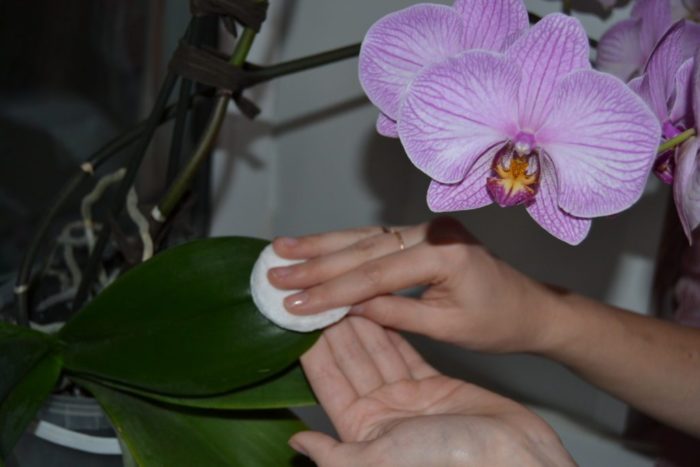
Chemical and biological agents
Pest control in many cases is more difficult than fungus control. The mealybug clings to its territory and will not leave it so easily.
The most effective drugs that can kill the parasite are:
- Fitoverm;
- Bankcol;
- Mospilan;
- Aktara.
All of these insecticides fight both adults and larvae. After treating the plant with the preparation, close it with a plastic bag and leave for 25–35 minutes. This will help enhance the effect of the product. Do not treat in a room in which someone lives: take diseased plants out into the street or at least on a non-residential balcony.
Observe precautions when working with chemicals: protect all exposed areas of the body, face, and eyes from accidental ingestion of the composition, and do not drink, smoke or eat while processing plants.
Treatment with folk methods
Folk recipes will help to cope with pests only at the initial stages of the development of the disease. Do not expect magical results from them if the parasite has already captured more than 50% of the flower.
The most effective remedies:
- Infusion of garlic. Take 5 garlic cloves, pour 1 liter of boiling water and leave for a day. Strain the finished mixture and treat the affected areas of the flower with it.
- Infusion of onions. Peel and chop one medium-sized onion. Pour the raw material with warm purified water, and leave the mixture to infuse for 2-3 hours. Strain the broth and sprinkle it on the orchid.
- Pepper infusion. Take 50 g of hot pepper, pour 500 ml of boiling water over it, then put it on the stove and boil for 5 minutes. Cool the finished mixture, and strain. Treat the diseased plant with a decoction.
What to do with white dots?
The only possible method for getting rid of white indented spots or white dots on an orchid is through careful grooming:
- normal watering regime;
- timely treatment of pathologies.
If you monitor the condition of your orchid, then the consequences of the illness will soon disappear.
Proper care for orchid to not become covered with White Sticky
In order to avoid such problems with the orchid, some preventive measures should be followed:
- Water the orchid only when the soil is completely dry.
- Periodically arrange a warm shower for flowers to remove excess moisture from the sheet plates.
- When the temperature drops, reduce the number of waterings.
- Use phytolamps to reduce daylight hours.
- Observe the temperature regime.
- Perform a preventive treatment every three months.
- Transplant orchids only into proven soil.
